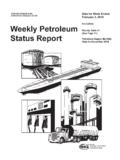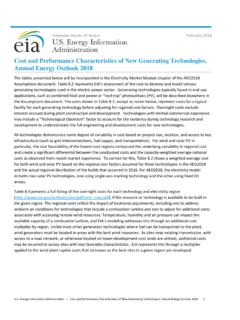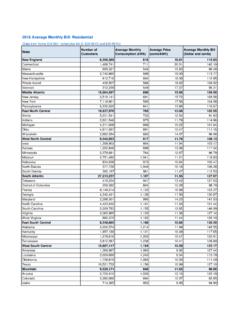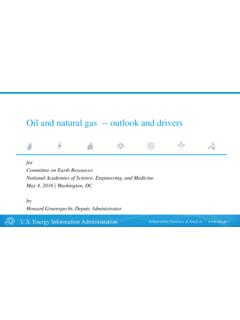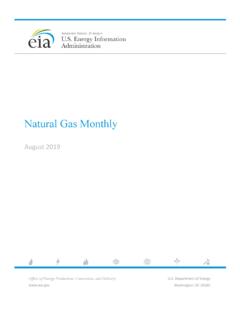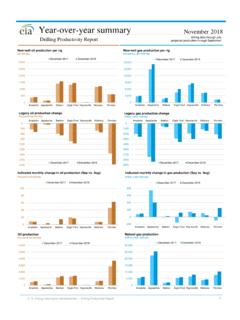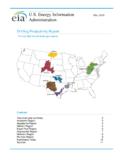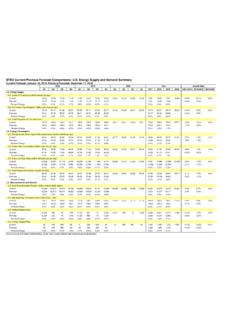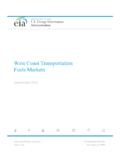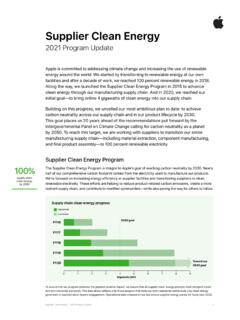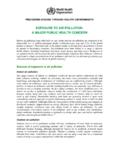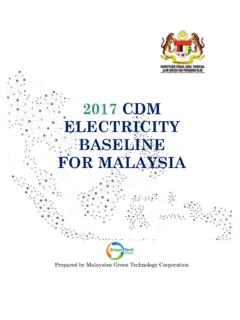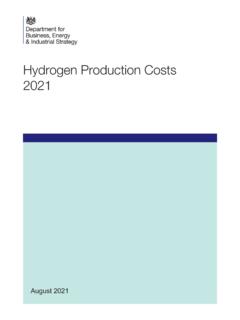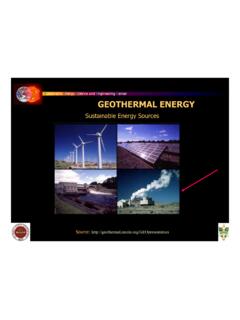Transcription of Electricity Market Module
1 January 2020 Energy Information Administration | Assumptions to the Annual Energy Outlook 2020: Electricity Market Module 1 Electricity Market Module The Electricity Market Module (EMM) in the Energy Information Administration s (EIA) National Energy Modeling System (NEMS) is composed of four submodules: Electricity load and demand, Electricity capacity planning, Electricity fuel dispatching, and Electricity finance and pricing. The EMM also includes nonutility capacity and generation as well as Electricity transmission and trade. A detailed description of the EMM is provided in the EIA publication, The Electricity Market Module of the National Energy Modeling System: Model Documentation 2018, DOE/EIA-M068 (2018). Based on fuel prices and Electricity demands provided by the other modules of NEMS, the EMM determines the most economical way to supply Electricity within environmental and operational constraints.
2 Each EMM submodule includes assumptions about the operations of the Electricity sector and the costs of various options. This section describes the model parameters and assumptions used in the EMM and discusses legislation and regulations that are incorporated in the EMM. EMM regions The supply regions used in the EMM were updated for EIA s Annual Energy Outlook 2020 (AEO2020) to account for changes in Independent System Operator (ISO) and Regional Transmission Organization (RTO) composition and to better represent power markets. The new regions follow North American Electric Reliability Corporation (NERC) assessment region boundaries and ISO region boundaries (as of early 2019), and subregions are based on regional pricing zones, as shown in Figure 1 and described in Table 1. Figure 1. Electricity Market Module regions Source: Energy Information Administration January 2020 Energy Information Administration | Assumptions to the Annual Energy Outlook 2020: Electricity Market Module 2 Table 1.
3 National Energy Modeling System Electricity Market Module regions Number Abbreviation NERC/ISO1 subregion name Geographic name2 1 TRE Texas Reliability Entity Texas 2 FRCC Florida Reliability Coordinating Council Florida 3 MISW Midcontinent ISO/West Upper Mississippi Valley 4 MISC Midcontinent ISO/Central Middle Mississippi Valley 5 MISE Midcontinent ISO/East Michigan 6 MISS Midcontinent ISO/South Mississippi Delta 7 ISNE Northeast Power Coordinating Council/ New England New England 8 NYCW Northeast Power Coordinating Council/ NYC & Long Island Metropolitan New York 9 NYUP Northeast Power Coordinating Council/Upstate NY Upstate New York 10 PJME PJM/East Mid-Atlantic 11 PJMW PJM/West Ohio Valley 12 PJMC PJM/Commonwealth Edison Metropolitan Chicago 13 PJMD PJM/Dominion Virginia 14 SRCA SERC Reliability Corporation/East Carolinas 15 SRSE SERC Reliability Corporation/Southeast Southeast 16 SRCE SERC Reliability Corporation/Central Tennessee Valley 17 SPPS Southwest Power Pool/South Southern Great Plains 18 SPPC Southwest Power Pool/Central Central Great Plains 19 SPPN Southwest Power Pool/North Northern Great Plains 20 SRSG Western Electricity Coordinating Council/Southwest Southwest 21 CANO Western Electricity Coordinating Council/CA North Northern California 22 CASO Western Electricity Coordinating Council/CA South Southern California 23 NWPP Western Electricity Coordinating Council/ Northwest Power Pool Northwest 24 RMRG Western Electricity Coordinating Council/Rockies Rockies 25 BASN Western Electricity Coordinating Council/Basin Great Basin 1 NERC=North American Electric Reliability Corporation, ISO=Independent System Operator.
4 2 Names are intended to describe approximate locations. Exact regional boundaries do not necessarily correspond to state borders or to other regional naming conventions. Source: Energy Information Administration January 2020 Energy Information Administration | Assumptions to the Annual Energy Outlook 2020: Electricity Market Module 3 Model parameters and assumptions Generating capacity types Capacity types represented in the EMM are shown in Table 2. Table 2. Generating capacity types represented in the Electricity Market Module Capacity type Existing coal steam plants1 Ultra-supercritical coal (USC) USC with 30% carbon capture and sequestration (CCS) USC with 90% CCS Oil/natural gas steam oil/natural gas steam turbine Combined-cycle (CC) single shaft (1x1x1)2 configuration Combined-cycle multi shaft (2x2x1)3 configuration Combined-cycle with CCS single shaft configuration with 90% CCS Internal combustion engine Combustion turbine (CT)
5 Aeroderivative Combustion turbine industrial frame Fuel cell solid oxide Conventional nuclear Advanced nuclear advanced light water reactor Generic distributed generation base load Generic distributed generation peak load Conventional hydropower hydraulic turbine Pumped storage hydraulic turbine reversible Battery storage four-hour lithium-ion battery Geothermal Municipal solid waste (MSW) landfill gas-fired internal combustion engine biomass fluidized bed Solar thermal central tower Solar photovoltaic (PV) single-axis tracking Solar PV fixed-tilt Wind Wind offshore 1 The EMM represents 32 types of existing coal steam plants, based on the different possible configurations of nitrogen oxide (NOx), particulate and sulfur dioxide (SO2) emission control devices, and options for controlling mercury and carbon (see Table 9). 2 Single-shaft (1x1x1) configuration with one H-class combustion turbine, one heat recovery steam generator, and one steam turbine generator.
6 3 Multi-shaft (2x2x1) configuration with two H-class combustion turbines, two heat recovery steam generators, and one steam turbine generator. Source: Energy Information Administration January 2020 Energy Information Administration | Assumptions to the Annual Energy Outlook 2020: Electricity Market Module 4 New generating plant characteristics Inputs to the Electricity capacity planning submodule are the cost and performance characteristics of new generating technologies (Table 3). In addition to these characteristics, fuel prices from the NEMS fuel supply modules and foresight on fuel prices are used to compare options when new capacity is needed. Heat rates for new fossil-fueled technologies are assumed to remain constant throughout the projection period. For AEO2020, an EIA consultant updated the current cost estimates for most utility-scale electric generating plants [1].
7 This report used a consistent estimation methodology across all technologies to develop cost and performance characteristics for technologies that we specified for consideration in the EMM. EIA did not use the costs the consultant developed for geothermal and hydro plants, because we continue to use previously developed site-specific costs. Costs for distributed generation plants in the power sector were also not updated for this report, and input assumptions remain as in previous AEOs. Inputs for all other technologies listed in Table 3 were updated for AEO2020. Except as noted below, the overnight costs shown in Table 3 represent the estimated cost of building a plant before adjusting for regional cost factors. Overnight costs exclude interest expenses during plant construction and development. Although not broken out as in previous AEOs, the base overnight costs include project contingency to account for undefined project scope, pricing uncertainty, and owners cost components.
8 Technologies with limited commercial experience may include a technological optimism factor to account for the tendency during technology research and development to underestimate the full engineering and development costs for new technologies. A cost-adjustment factor, based on the producer price index for metals and metal products, allows the overnight capital costs in the future to drop if this index decreases or to rise if it increases. All technologies demonstrate some degree of variability in cost, based on project size, location, and access to key infrastructure (such as grid interconnections, fuel supply, and transportation). For onshore wind and solar photovoltaic (PV), in particular, the cost favorability of the lowest-cost regions compounds the underlying variability in regional cost and creates a significant differential between the unadjusted costs and the capacity-weighted average national costs as observed from recent Market experience.
9 To correct for this difference, Table 3 shows a weighted-average cost for both onshore wind and solar PV based on the regional cost factors assumed for these technologies in AEO2020 and the actual regional distribution of wind and solar builds that occurred in 2018. Table 4 lists the overnight capital costs for each technology and EMM region (Figure 1) for the resources or technologies that are available to be built in each region. The regional costs reflect the impact of locality adjustments, including one to address ambient air conditions for technologies that include a combustion turbine and one to adjust for additional costs associated with accessing remote wind resources. Temperature, humidity, and air pressure can affect the available capacity of a combustion turbine, and EIA s modeling addresses this possibility through an additional cost multiplier by region.
10 Unlike most other generation technologies where fuel can be transported to the plant, wind generators must be located in areas with the best wind resources. Sites that are located near existing transmission with access to a road network or are otherwise located on lower-development-cost lands are generally built up first, after which additional costs may be incurred to access sites with less favorable characteristics. EIA represents this trend January 2020 Energy Information Administration | Assumptions to the Annual Energy Outlook 2020: Electricity Market Module 5 through a multiplier applied to the wind plant capital costs that increases as the best sites in a given region are developed. January 2020 Energy Information Administration | Assumptions to the Annual Energy Outlook 2020: Electricity Market Module 6 Table 3. Cost and performance characteristics of new central station Electricity generating technologies technology First available year1 Size (MW) Lead time (years) Base overnight cost2 (2019 $/kW) Techno-logical optimism factor3 Total overnight cost4,5 (2019 $/kW) Variable O&M6 (2019 $/MWh) Fixed O&M (2019$/ kW-yr) Heat rate7 (Btu/kWh) Ultra-supercritical coal (USC) 2023 650 4 3,661 3,661 8,638 USC with 30% carbon capture and sequestration (CCS)
